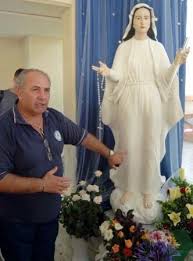|
 By Steve Ryan By Steve Ryan
Italy: Hundreds demand return of 'miraculous' statue
Hàng trăm tín hữu của thành phố Acerra, gần Naples vào ngày 3 tháng 7 đã xin vị giám mục địa phận trao trả lại thánh tượng Đức Trinh Nữ Maria làm phép lạ.
Vị giám mục tên Giovanni Rinaldi đã lấy đi thánh tượng từ một ngôi nhà thờ nhỏ tên Thánh Phêrô Tông Đồ vào năm 2006, sau khi có những báo cáo từ hàng ngàn người nói rằng họ thấy hiện tượng lạ là chân của thánh tượng di động sau chiếc áo choàng.
- Hundreds of believers in town of Acerra, near Naples, on July 3 have asked a local bishop to return a statue of the Virgin Mary, believed to be miraculous.
Giovanni Rinaldi removed the statue from the small church of San Peter the Apostle in 2006 after reports that thousands of people claimed to have seen the legs of the statue appear through the dress of the statue and move.
Rinaldi ordered an investigation to verify the claims.
The faithful collected over 200 signatures asking the bishop to return the statue and are expected to deliver their request to him in the next few days, said local daily Il Mattino.
"After an article published in a special publication dedicated to the Virgin of Medjugorje, we decided to go ahead with the petition. In the article it said the Virgin prepared an army of devotees, which held a cross on one hand and a rosary on the other, just like the statue of Acerra," said Franco Barbetta, coordinator of the local civil defence department.
Acerra is a small town of 54,000 inhabitants located 20 kilometres outside Naples, the provincial capital of Campania.
From Mary Pages One group of pilgrims claim to have filmed a miraculous “walking statue” of the Madonna with their video phones on Sunday, July 24, 2005 in the Church of San Pietro in the town of Acerra near Naples, Italy. According to witnesses, the statue’s legs have moved repeatedly over the last few days. The hands and feet of the Madonna had begun to “take human form, flesh and blood”. They will show the footage to the Bishop of Acerra, Monsignor Giovanni Rinaldi, who will decide whether the celluloid "proof", together with photographs purportedly taken with mobile telephones, warrant examination by a special church commission that investigates reports of apparitions.
Parishioners said that the movement had first been noticed by cleaners, who had kept silent for fear of being disbelieved. They claim not to have been the victims of mass hysteria. Many drew an analogy with the “weeping Madonna of Civitavecchia”, a statue brought from a shrine at Medjugorge in Bosnia-Herzegovina, which ten years ago was said to have cried blood. The Civitavecchia “miracle” has never been recognised by the Vatican but the town — a port on the coast near Rome — has benefited from the phenomenon, with the local authorities building a reception centre for pilgrims.
The 160cm (63inch) high statue, made of plaster and marble dust, was installed at the church last December. Father Oreste Santoro, the parish priest, said that he had not seen the statue move. Thousands of Italians have flocked to the Church of San Pietro.
Mgr Antonio Riboldi, the retired bishop of Acerra, also urged caution, saying that “these matters are often difficult to comprehend. The Church proceeds with great prudence where apparitions of the Virgin Mary are concerned”. The Vatican has approved 15 “authentic apparitions” by the Virgin Mary since 1830, but only one “weeping Madonna”, a statue at Siracusa in Sicily that wept “tears of blood” in 1954. |